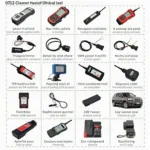The question “does a 4G Acura TL have an obd2 sensor in the cat?” is a common one among owners, especially those encountering check engine lights. Understanding the intricacies of your Acura TL’s emissions system, specifically the catalytic converter and its associated sensors, is crucial for proper maintenance and diagnosis. This article will delve into the specifics of the 4G Acura TL’s OBD2 system and its relationship with the catalytic converter.
Understanding the OBD2 System in a 4G Acura TL
The OBD2 (On-Board Diagnostics, generation 2) system is a standardized system present in all vehicles manufactured after 1996, including the 4G Acura TL. This system acts as your car’s internal diagnostic computer, constantly monitoring various systems and components, including the engine, transmission, and emissions system. When a problem is detected, the OBD2 system triggers the check engine light and stores a diagnostic trouble code (DTC) in its memory. These codes can then be retrieved using an OBD2 scanner, providing valuable insight into the nature of the issue.
The Role of the Catalytic Converter
The catalytic converter is a critical component of your Acura TL’s emissions system. Its primary function is to convert harmful pollutants in exhaust gases into less harmful substances before they are released into the atmosphere. This process is crucial for environmental protection and maintaining air quality.
OBD2 Sensors and the Catalytic Converter
The 4G Acura TL does indeed have OBD2 sensors related to the catalytic converter. These are typically oxygen sensors (O2 sensors) located both upstream and downstream of the converter. The upstream sensor measures the oxygen content in the exhaust gases before they enter the converter, while the downstream sensor measures the oxygen content after the gases have passed through the converter. By comparing the readings from these two sensors, the OBD2 system can determine the efficiency of the catalytic converter.
 4G Acura TL OBD2 Sensor Location in Catalytic Converter
4G Acura TL OBD2 Sensor Location in Catalytic Converter
Common Issues Related to Catalytic Converter OBD2 Sensors in a 4G Acura TL
Several issues can arise with the catalytic converter and its associated sensors in a 4G Acura TL. These include:
- Failing Oxygen Sensors: A faulty oxygen sensor can provide inaccurate readings to the OBD2 system, triggering a check engine light even if the catalytic converter is functioning correctly.
- Catalytic Converter Failure: A damaged or malfunctioning catalytic converter can also trigger a check engine light. This is often indicated by specific DTCs related to catalyst efficiency.
- Wiring Problems: Damaged or corroded wiring connecting the sensors to the OBD2 system can also cause issues and trigger fault codes.
- Exhaust Leaks: Leaks in the exhaust system can affect the readings of the oxygen sensors and potentially damage the catalytic converter.
Diagnosing and Addressing Catalytic Converter Issues
If you suspect an issue with your 4G Acura TL’s catalytic converter or its related sensors, it’s essential to use an OBD2 scanner to retrieve the diagnostic trouble codes. These codes will provide valuable information about the specific problem.
“A proper diagnosis is crucial before replacing any parts,” says renowned automotive diagnostician, Robert Johnson. “Using a quality OBD2 scanner and understanding the codes is the first step in resolving catalytic converter issues.”
Using an OBD2 Scanner
Connecting an OBD2 scanner to your Acura TL’s diagnostic port allows you to read the stored DTCs. Once you have the codes, you can research their meaning and determine the appropriate course of action.
Seeking Professional Help
While some issues can be addressed with DIY solutions, more complex problems may require the expertise of a qualified mechanic. They can perform a thorough inspection and provide accurate diagnosis and repair.
Conclusion
The 4G Acura TL does have OBD2 sensors in its catalytic converter system, specifically oxygen sensors that monitor its efficiency. Understanding the function of these sensors and how to diagnose related issues using an OBD2 scanner is crucial for maintaining your vehicle’s performance and emissions control. Don’t hesitate to seek professional help if you encounter any issues with your catalytic converter or OBD2 system.
FAQ
- What are the common symptoms of a failing catalytic converter?
- How much does it cost to replace a catalytic converter on a 4G Acura TL?
- Can I drive my Acura TL with a faulty catalytic converter?
- How often should I check my catalytic converter?
- What is the difference between upstream and downstream oxygen sensors?
- How can I prevent catalytic converter problems?
- What are the common OBD2 codes related to the catalytic converter?
For further assistance, contact us via WhatsApp: +1(641)206-8880, Email: [email protected] or visit us at 789 Elm Street, San Francisco, CA 94102, USA. Our 24/7 customer support team is always ready to help.

